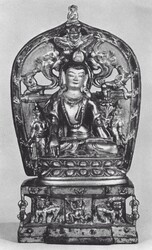
Buddhist Deity: Avalokiteshvara Iconic Forms
Avalokiteshvara IconographySubjects, Topics & Types:
- Description (below)
- Iconographic Index
- Iconography by Text
- Categories & Divisions
- Compendium Paintings
- Slighty Wrathful Forms
- Source Texts
- Confusions
- Others...
Videos: Avalokiteshvara
Iconic forms of Lokeshvara refers to the descriptions of the appearance of the various forms of the deity as found in the original tantras and the tantric commentaries and 'Revealed Treasure' teachings. Iconic figures are fixed in their appearance as if static as opposed to non-iconic figures which can be dynamic, only limited by the imagination of the artist, and cultural character of a region and time.
Iconic Lokeshvara figures are meditational deities. They can be simple or complex in appearance with single or multiple faces and arms. Where the non-iconic forms are quiescent in appearance, the iconic forms can be represented by all three moods of peaceful, semi-peaceful/semi-wrathful, and wrathful, along with the colours of the four activities and inhabit mandala configurations.
Six Principal Iconographic Forms (Vajrayana):
1. Amoghapasha
2. Chaturbhuja
3. Eleven Faces
4. Jinasagara
5. Khasarpana
6. Simhanada
- Mandala (All)
- Others...
Database Search: All Images | Paintings | Sculpture | Mandalas
Jeff Watt [page added 11-2020]
(The images below are only a selection of examples from the links above).




